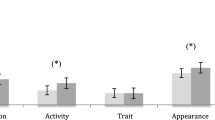Abstract
Sex-role perceptions were approached from an out-of-role attributional framework, with the predictions that out-of-role behavior would be rated more extreme than in-role behavior on sex-role stereotype scales and that out-of-role behavior would be seen as more internally determined. One hundred and twenty male and female college students heard one of four tapes in which the two stimulus persons (SPs), male and female, behaved in sex-role consistent or inconsistent behavior using the dimension of dominance-submission (DM-DF, SM-SF, DM-SF, DF-SM). The DF, compared to the DM, was attributed more masculinity and less femininity. The DF's behavior, compared to the DM, was seen as originating more from internal than situational causes.
Similar content being viewed by others
References
Bem, S. The measurement of psychological androgyny. Journal of Consulting and Clinical Psychology, 1974, 42, 155–162.
Broverman, I. K., Broverman, D., Clarkson, E., Rosenkrantz, P., & Vogel, S. Sex-role stereotypes and clinical judgments of mental health. Journal of Consulting and Clinical Psychology, 1970, 34, 1–7.
Deaux, K., & Emswiller, T. Explanations of successful performance on sex-linked tasks: What is skill for the male is luck for the female. Journal of Personality and Social Psychology, 1974, 29, 80–85.
Feldman-Summers, S. A., & Kiesler, S. B. Those who are number two try harder: The effect of sex on attributions of causality. Journal of Personality and Social Psychology, 1974, 30, 846–855.
Jones, E., & Davis, K. From acts to dispositions: The attribution process in person perception. In L. Berkowitz (Ed.), Advances in experimental social psychology (Vol. 2). New York: Academic Press, 1965.
Jones, E., Davis, K., & Gergen, K. Role-playing variations and their informational value for person perception. Journal of Abnormal and Social Psychology, 1961, 63, 302–310.
Jones, E., & Nisbett, R. The actor and the observer: Divergent perceptions of the causes of behavior. Morristown, N.J.: General Learning Press, 1971.
Jones, E., & Thibaut, J. Interaction goals as bases of influence in interpersonal perception. In R. Tagiuri & L. Petrullo (Eds.), Person perception and interpersonal behavior. Stanford: Stanford University Press, 1958. Pp. 151–170.
Kirk, R. E. Experimental design: Procedures for the behavioral sciences. Belmont, Calif.: Brooks/Cole, 1968.
McKee, J., & Sherriffs, A. The differential evaluation of males and females. Journal of Personality, 1957, 25, 356–363.
Neulinger, J. Perceptions of the optimally integrated person: A redefinition of mental health. Symposium presented at the 76th meeting of the American Psychological Association, 1968.
Pheterson, G. I., Kiesler, S. B., & Goldberg, P. A. Evaluation of the performance of women as a function of their sex, achievement, and personal history. Journal of Personality and Social Psychology, 1971, 17, 229–235.
Rosenkrantz, P., Vogel, S., Bee, H., Broverman, I., & Broverman, D. Sex-role stereotypes and self-concepts in college students. Journal of Consulting and Clinical Psychology, 1968, 32, 287–295.
Steinmann, A., & Fox, D. Sex and ideal sex-role perceptions of men and women and their ideal perceptions of each other. In B. F. Riess (Ed.), New directions in mental health. New York: Grune and Stratton, 1968. Pp. 232–243.
Taynor, J., & Deaux, K. Equity and perceived sex differences: Role behavior as defined by the task, the mode, and the actor. Journal of Personality and Social Psychology, 1975, 3, 381–390.
Terman, L. M., & Tyler, L. E. Psychological sex differences. In L. Carmichael (Ed.), Manual of child psychology. New York: Wiley, 1954.
Thibaut, J., & Kelley, H. The social psychology of groups. New York: Wiley, 1959.
Thibaut, J., & Riecken, H. Some determinants and consequences of the perception of social casuality. Journal of Personality, 1955, 24, 113–133.
Author information
Authors and Affiliations
Rights and permissions
About this article
Cite this article
Cowan, G., Koziej, J. The perception of sex-inconsistent behavior. Sex Roles 5, 1–10 (1979). https://doi.org/10.1007/BF00289340
Issue Date:
DOI: https://doi.org/10.1007/BF00289340




